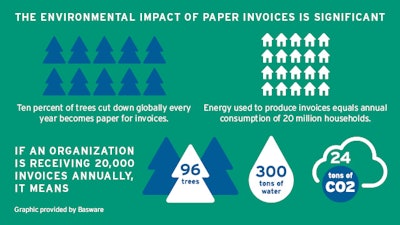
With the atmosphere’s current carbon dioxide level hovering around 413 parts per million (ppm), companies are recognizing their impact on the environment and looking for ways to adopt sustainable business practices. Through the powers of technology and invoice automation, organizations can now track their CO2 index.
Out with paper
When paper reaches the end of its life cycle, it’s sent off to a landfill or incinerated, thus producing greenhouse gases like CO2 as it breaks down. When we produce and dispose of these paper products at a faster pace than the plants and trees can consume the CO2, we create an over-abundance of CO2 in the atmosphere.
Take a look around your office. If you’re still receiving paper invoices by mail or getting a PDF invoice by email, printing it out and then re-entering the information by hand into your accounting system, there’s a better way to improve your processes and help reduce your carbon footprint.
Purchase-to-pay processes cut carbon significantly
The answer is automation—electronic purchase-to-pay (P2P) services are a clear winner over paper-based, manual processes. To learn just how much digitizing finance and procurement can help with sustainability, Basware teamed up 3keel to complete a CO2 emission study and analyze scientific and industry reports on how kicking the paper habit affects climate change and greenhouse gas emissions.
Just think about how much your company could decrease its own carbon footprint through adopting sustainably solutions like e-invoicing, S2P automation and a holistic digitization of your organization’s processes. The more businesses that think this way, the less affect we’ll have on increasing CO2.
How to make a difference with digital purchase to pay
First and foremost, the obvious answer is the more automated your processes are, the less paper that is required to support your business.
- Get rid of an over-reliance of paper and reduce your contribution to CO2 emissions, while reaping the benefits of cost savings and efficiency.
Secondly, the largest source of human-induced CO2 emissions comes from using coal, oil, gasoline and diesel. So, start considering how a digital workplace can enable other sustainable business practices:
- A digital process means you can encourage remote work. Working from home decreases emissions from one of the costliest contributors of the carbon problem—transportation. Every gallon of fuel burned creates about 20 pounds (or 9 kilograms) of carbon dioxide.
- Cloud computing means less infrastructure is required to power your business from a hardware and IT perspective. So that means fewer servers and less equipment are needed, decreasing CO2 emissions produced from those items.
- Efficient procurement processes enable bundled orders and shipments, meaning less pollution from fewer deliveries and less packaging materials needed.
- Connecting to a business network means you can identify new sustainable suppliers and source goods and materials from companies that share your values.
- Funding for other sustainability measures can be generated from the cost savings you realize with going digital.
So, it’s not only about the paper; it’s about an overall more efficient way of operating. The less working hours you spend on the P2P process, the less energy you need, leading to less emissions.
How does the CO2 dashboard work?
The carbon footprint index is calculated based on the environmental impact of different invoice receiving methods. Companies can follow the development of their own CO2 index over time, as well as benchmark against the average carbon footprint. The dashboard also estimates how many trees or how much water you have saved or can save if you onboard more suppliers to e-invoicing. Companies can also view improvement potential per month.












